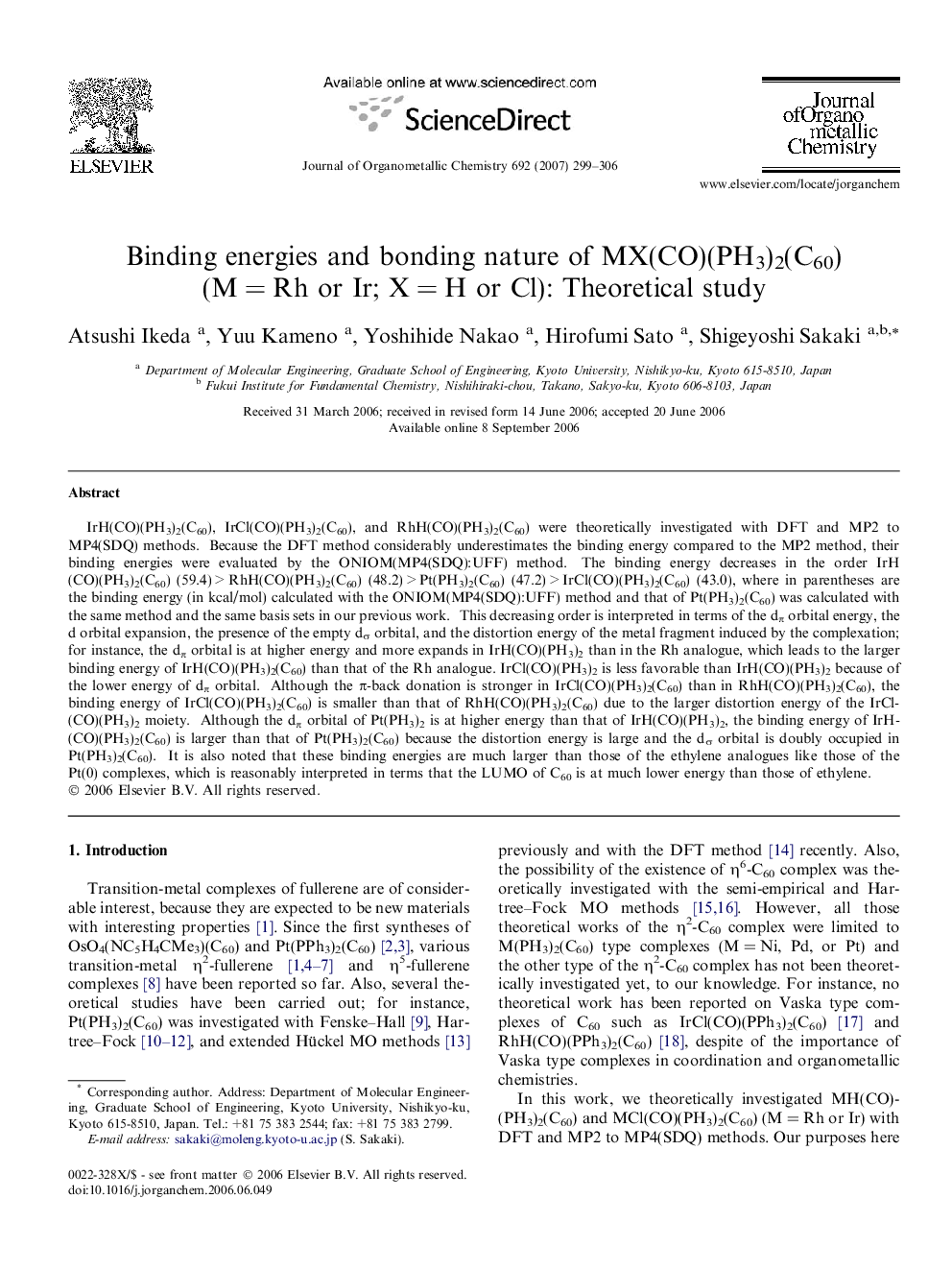| کد مقاله | کد نشریه | سال انتشار | مقاله انگلیسی | نسخه تمام متن |
|---|---|---|---|---|
| 1328321 | 1499949 | 2007 | 8 صفحه PDF | دانلود رایگان |

IrH(CO)(PH3)2(C60), IrCl(CO)(PH3)2(C60), and RhH(CO)(PH3)2(C60) were theoretically investigated with DFT and MP2 to MP4(SDQ) methods. Because the DFT method considerably underestimates the binding energy compared to the MP2 method, their binding energies were evaluated by the ONIOM(MP4(SDQ):UFF) method. The binding energy decreases in the order IrH(CO)(PH3)2(C60) (59.4) > RhH(CO)(PH3)2(C60) (48.2) > Pt(PH3)2(C60) (47.2) > IrCl(CO)(PH3)2(C60) (43.0), where in parentheses are the binding energy (in kcal/mol) calculated with the ONIOM(MP4(SDQ):UFF) method and that of Pt(PH3)2(C60) was calculated with the same method and the same basis sets in our previous work. This decreasing order is interpreted in terms of the dπ orbital energy, the d orbital expansion, the presence of the empty dσ orbital, and the distortion energy of the metal fragment induced by the complexation; for instance, the dπ orbital is at higher energy and more expands in IrH(CO)(PH3)2 than in the Rh analogue, which leads to the larger binding energy of IrH(CO)(PH3)2(C60) than that of the Rh analogue. IrCl(CO)(PH3)2 is less favorable than IrH(CO)(PH3)2 because of the lower energy of dπ orbital. Although the π-back donation is stronger in IrCl(CO)(PH3)2(C60) than in RhH(CO)(PH3)2(C60), the binding energy of IrCl(CO)(PH3)2(C60) is smaller than that of RhH(CO)(PH3)2(C60) due to the larger distortion energy of the IrCl-(CO)(PH3)2 moiety. Although the dπ orbital of Pt(PH3)2 is at higher energy than that of IrH-(CO)(PH3)2, the binding energy of IrH(CO)(PH3)2(C60) is larger than that of Pt(PH3)2(C60) because the distortion energy is large and the dσ orbital is doubly occupied in Pt(PH3)2(C60). It is also noted that these binding energies are much larger than those of the ethylene analogues like those of the Pt(0) complexes, which is reasonably interpreted in terms that the LUMO of C60 is at much lower energy than those of ethylene.
IrH(CO)(PH3)2(C60), IrCl(CO)(PH3)2(C60), and RhH(CO)(PH3)2(C60) were theoretically investigated with DFT and MP2 to MP4(SDQ) methods. The coordinate bond of C60 becomes strong in the order IrCl(CO)(PH3)2(C60) < RhH(CO)(PH3)2(C60) < IrH(CO)(PH3)2(C60), which is reasonably interpreted in terms of d orbital energy, d orbital expansion, and distortion energy of the metal moiety.Figure optionsDownload as PowerPoint slide
Journal: Journal of Organometallic Chemistry - Volume 692, Issues 1–3, 1 January 2007, Pages 299–306